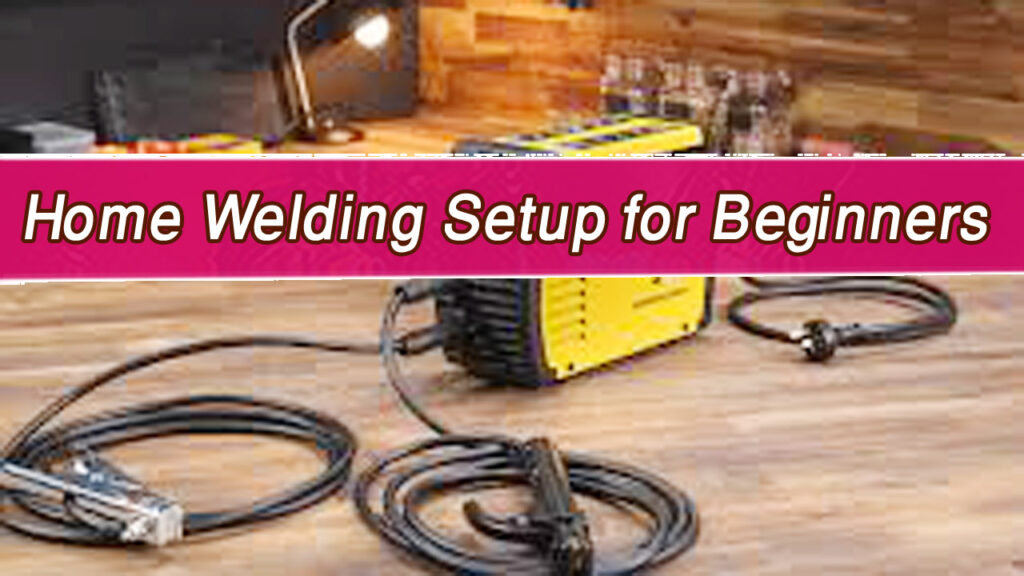Are you ready to dive into the exciting world of welding but don’t know where to start? Setting up a home welding station might seem overwhelming, but trust me, it’s simpler than you think. I’ve been through the same stage, and with some trial and error, I’ve learned how to create a reliable and safe setup for welding right at home.
Let me walk you through everything you need to get started, so you can embark on your welding journey with confidence.

Why Consider Welding at Home?
Welding is a highly versatile skill that allows you to repair, create, and innovate. Whether you want to fix a broken gate, craft custom metalwork, or take on DIY projects, welding gives you the power to bring your ideas to life.
Having a home setup means no more trips to the workshop, saving you time and money while providing the convenience of working on your schedule.
Choosing the Right Welding Method
When starting, it’s essential to pick the right welding method based on your needs. Here are the most common ones for beginners:
MIG Welding
- Why It’s Great for Beginners: It’s straightforward, forgiving, and works well with various materials like steel and aluminum.
- How It Works: Uses a spool of wire fed through the machine, creating a clean and easy-to-control arc.
Stick Welding
- Why It’s Popular: Affordable and effective for thicker materials.
- Challenges: Requires practice to master, as it can produce more splatter and messy welds.
TIG Welding
- Why It’s Advanced: Perfect for precision work and thin materials.
- Downside for Beginners: Has a steeper learning curve and requires more equipment.
For your first home setup, MIG welding is the best option. It’s beginner-friendly and versatile enough for most projects.
Essential Tools and Equipment for Your Home Welding Setup
To start welding at home, you’ll need a few key items. Here’s what should be on your checklist:
A Welding Machine
Your welding machine is the heart of your setup. For beginners, I recommend a MIG welder with adjustable settings. Look for something lightweight and portable, especially if you’re working in a small space.
Protective Gear
Safety is non-negotiable in welding. Invest in these essential items:
- Welding Helmet: Auto-darkening helmets are a game changer for beginners.
- Gloves: Heat-resistant welding gloves protect your hands from burns and sparks.
- Jacket or Apron: A fire-resistant jacket or leather apron will keep you safe from flying sparks.
- Boots: Steel-toe boots offer excellent foot protection.
Welding Table
A sturdy, fireproof surface is a must for your projects. If you don’t want to buy a pre-made table, you can create one using scrap metal and a little ingenuity.
Clamps and Magnets
These are lifesavers when you need to secure metal pieces for precise welding.
A Grinder
Welds don’t always come out clean, especially when you’re learning. A grinder helps smooth out rough edges for a polished finish.
Ventilation System
Welding produces fumes that can be harmful in enclosed spaces. Ensure your workspace has proper ventilation or invest in a fume extractor.
Setting Up Your Welding Workspace
Creating a safe and efficient workspace is vital. Here’s how to set it up:
Pick the Right Location
Choose a space that’s well-ventilated, like a garage or a shed. Ensure it’s free from flammable materials like paper, fabric, or chemicals.
Organize Your Tools
Keep everything within arm’s reach. Install shelves or a pegboard to store your tools neatly. This not only saves time but also ensures your workspace stays safe and clutter-free.
Install Proper Lighting
Good lighting helps you see what you’re welding and reduces mistakes. Consider LED lights for bright and focused illumination.
Safety Tips for Beginner Welders
Safety should always come first in welding. Here are some important tips to keep in mind:
- Never Weld Without Protective Gear: Even a quick tack weld can produce dangerous sparks and UV rays.
- Inspect Your Equipment: Check your welder, cables, and connections for damage before each use.
- Keep a Fire Extinguisher Handy: Accidents happen, so it’s better to be prepared.
- Practice Fire Safety: Avoid welding near flammable materials, and keep your workspace clean.
- Take Breaks: Welding requires focus, and fatigue can lead to mistakes.
Learning the Basics: Practice Makes Perfect
Welding is a skill that improves with practice. Start with scrap metal to get the hang of creating steady, clean welds. Focus on controlling the arc, maintaining a consistent speed, and adjusting your machine settings.
YouTube tutorials, welding forums, and community workshops are excellent resources for beginners. Don’t hesitate to reach out to experienced welders for advice—they’re often more than happy to share tips and tricks.
Tackling Your First Welding Project
Once you feel comfortable with your equipment, start with a simple project. A few beginner-friendly ideas include:
- Metal Picture Frames
- Tool Holders
- Plant Stands
These projects are small, manageable, and provide a great sense of accomplishment.
Troubleshooting Common Welding Issues
As a beginner, you’ll likely encounter some hiccups. Here’s how to handle common problems:
- Porosity in Welds: Check for gas flow issues or contaminants on the metal surface.
- Uneven Weld Beads: Practice maintaining a consistent hand speed and distance.
- Spatter: Adjust your voltage and amperage settings to minimize mess.
Don’t get discouraged if your first few welds aren’t perfect. Every professional welder started as a beginner, and mistakes are part of the learning process.
Joy of Welding at Home
There’s something deeply satisfying about creating something with your own hands. Welding allows you to bring your ideas to life and gives you a sense of accomplishment. Over time, you’ll refine your skills and expand your project repertoire, making your home setup an invaluable asset.
FAQs
How much does it cost to set up a home welding station?
A basic setup can cost between $500 and $1,000, depending on the quality of the tools and equipment you choose.
Can I weld indoors?
Yes, but you must ensure proper ventilation to avoid inhaling harmful fumes.
Is welding safe for beginners?
Absolutely, as long as you follow safety guidelines and wear the proper protective gear.
How long does it take to learn welding?
Most beginners can pick up basic skills in a few weeks with regular practice, but mastering advanced techniques may take longer.
Can I use a regular table for welding?
No, it’s important to use a fireproof welding table to prevent accidents.
Conclusion
Setting up a home welding station as a beginner is an exciting step toward mastering a valuable skill. With the right tools, workspace, and a commitment to safety, you can create, repair, and explore welding projects with confidence. Start small, be patient, and enjoy the process—it’s incredibly rewarding to see what you can accomplish.
Ready to fire up your welder and dive in? Let’s make sparks fly!

Endow Russel the owner chief editor of giftendow.com . I am a mechanical engineer and assign to an local firm with much experience in welding and industrial equipment.

